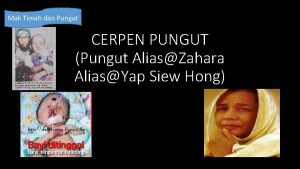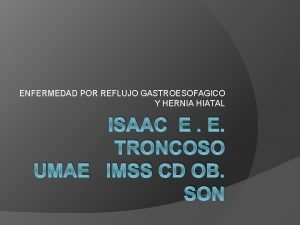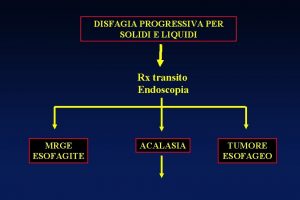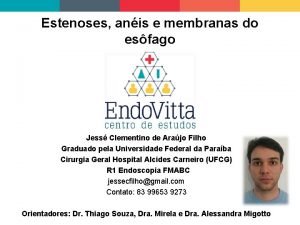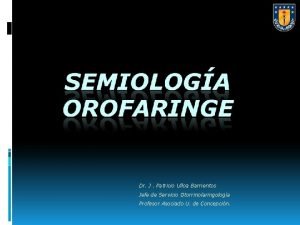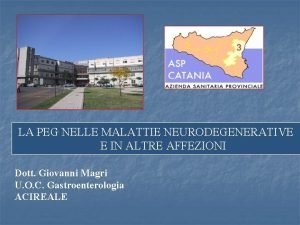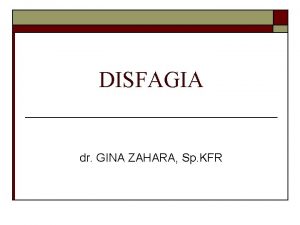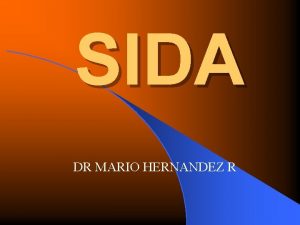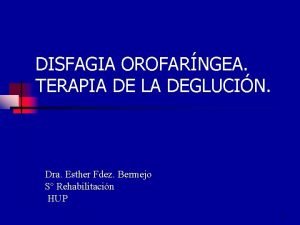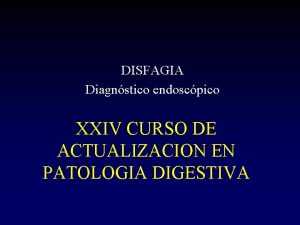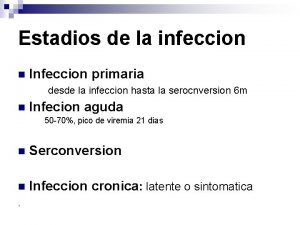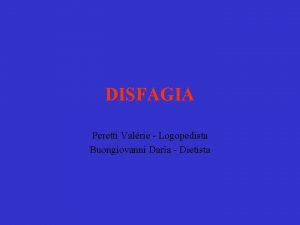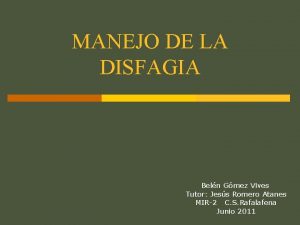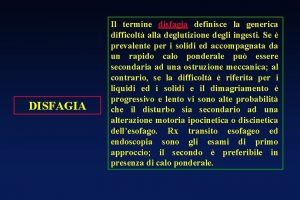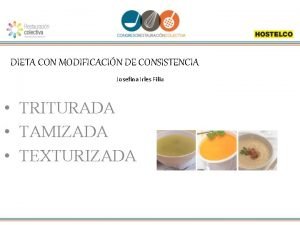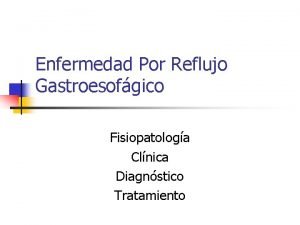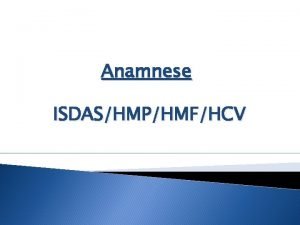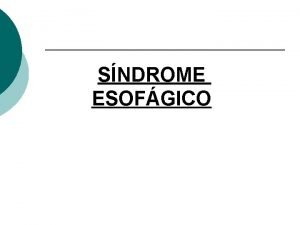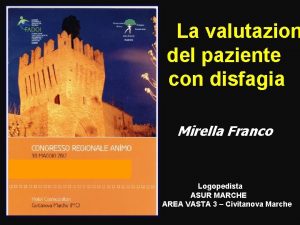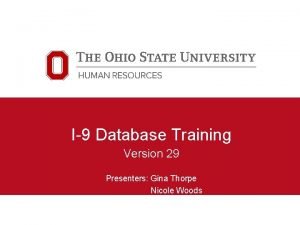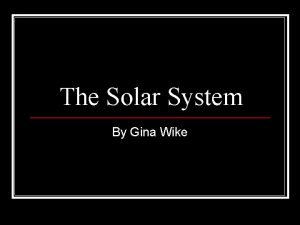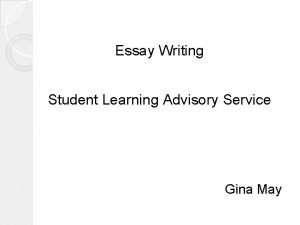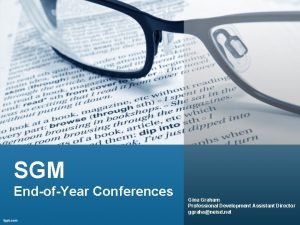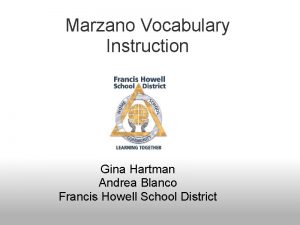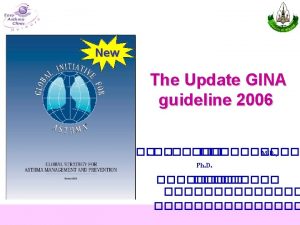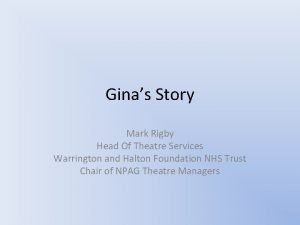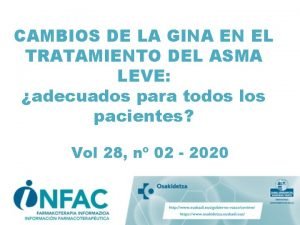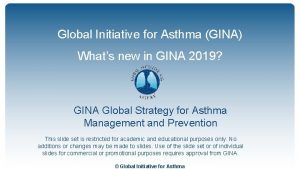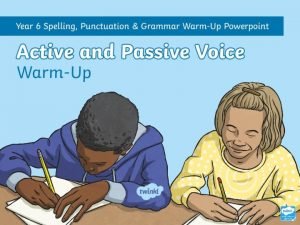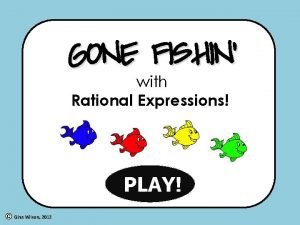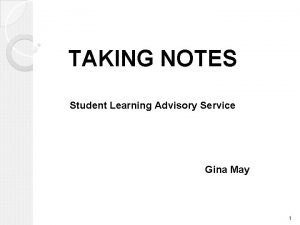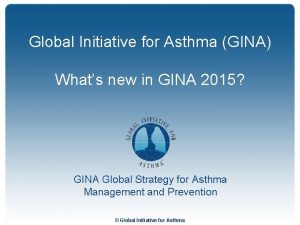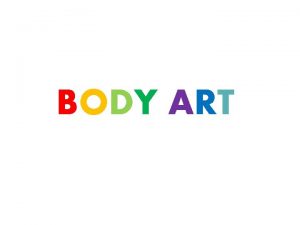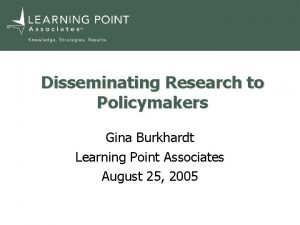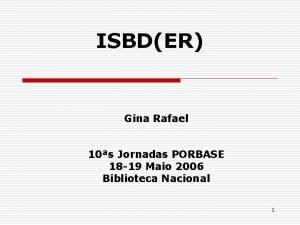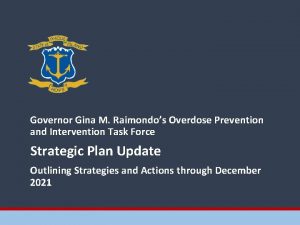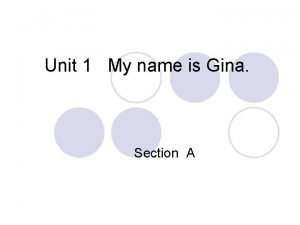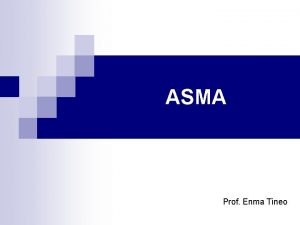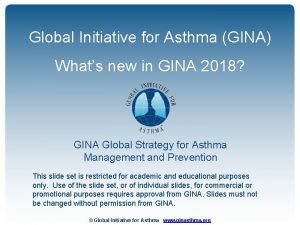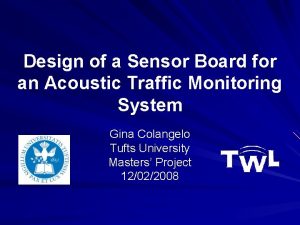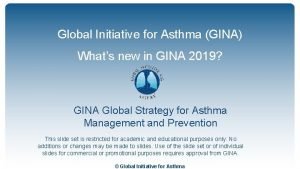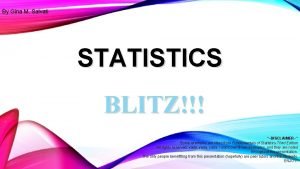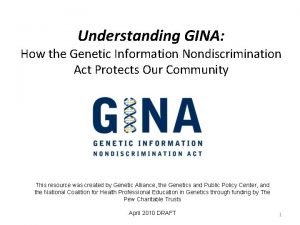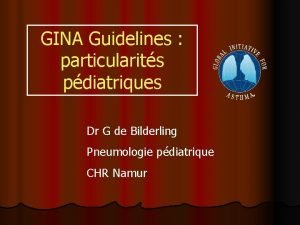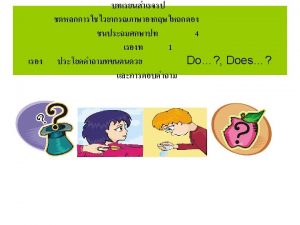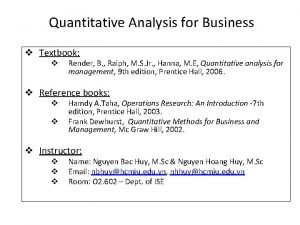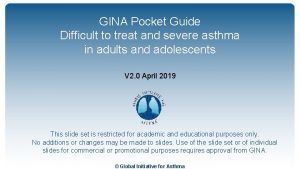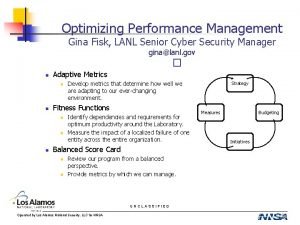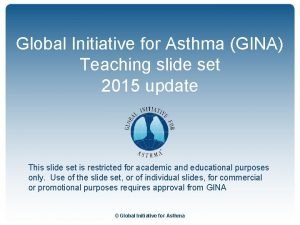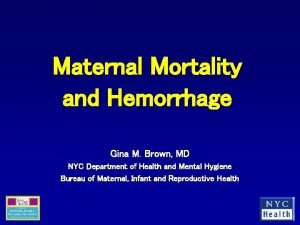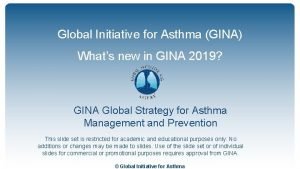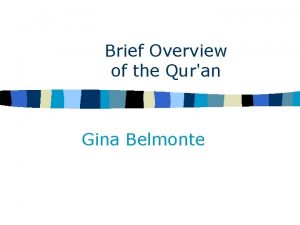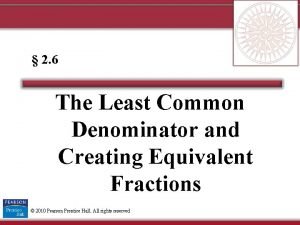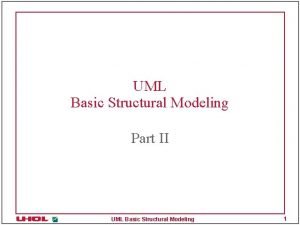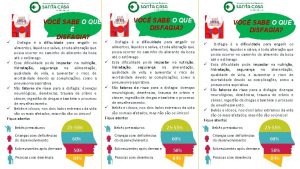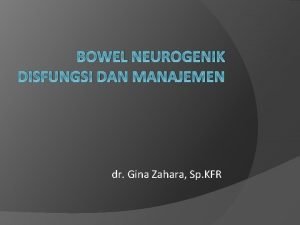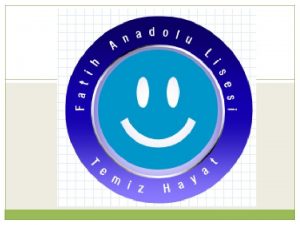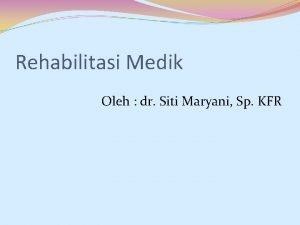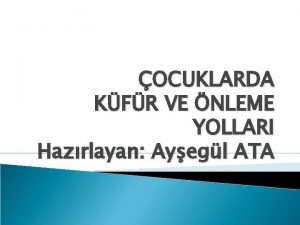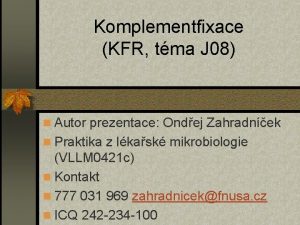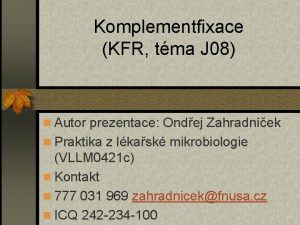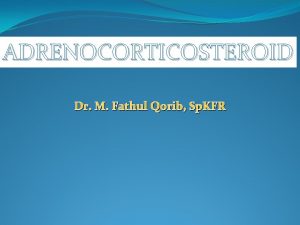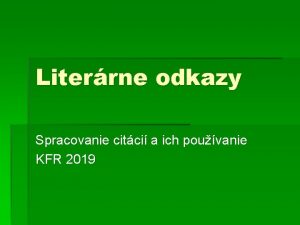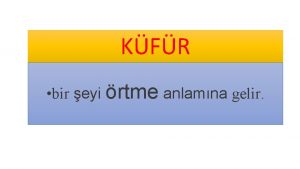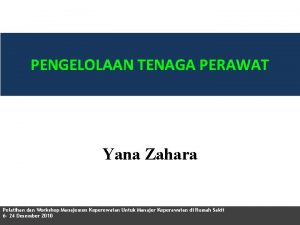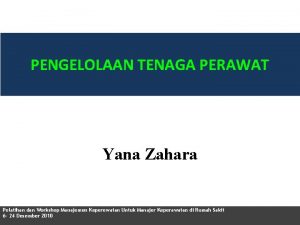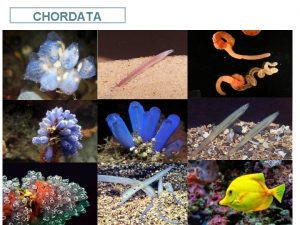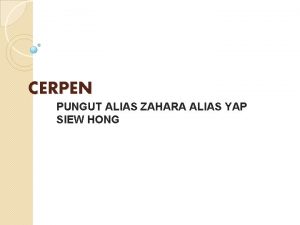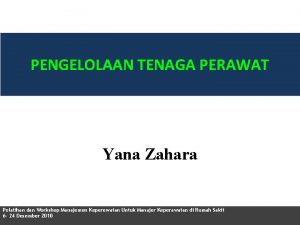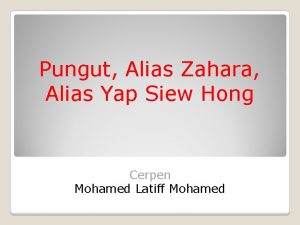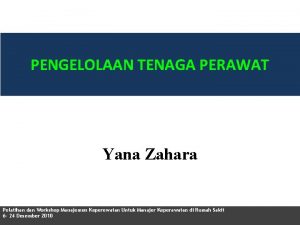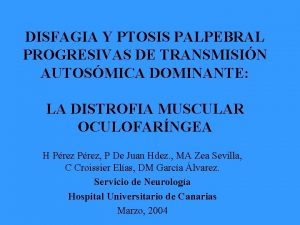DISFAGIA dr GINA ZAHARA Sp KFR 2 Common




























































































- Slides: 92

DISFAGIA dr. GINA ZAHARA, Sp. KFR

2

Common Terms o o o Dysphagia Also frequently referred to as a swallowing disorder, is when it is difficult to swallow. Bolus Food or liquid in the mouth that is ready to be swallowed or is in the process of being swallowed. Mastication The process of chewing food Aspiration Food, liquid, or saliva is in the airway beneath the vocal folds. Silent Aspiration Food, liquid, or saliva is in the airway beneath the vocal folds, and no coughing or change in voice occurs

DEFINISI o o o o Inability to swallow Regurgitation Painful swallowing Coughing/choking Food “sticks” Globus Feels “tight”

Anatomi Gambar 1. Anatomi laring faring Diambil dari: Van De Graaff: Human Anatomy, Sixth Edition, The Mc. Graw−Hill Companies, 2001 5

SWALLOWING o o o Mechanism is complex Involves the actions of 26 muscles and 5 cranial nerves n CN V -- both sensory and motor fibers; important in chewing n CN VII -- both sensory and motor fibers; important for sensation of oropharynx & taste to anterior 2/3 of tongue n CN IX -- both sensory and motor fibers; important for taste to posterior tongue, sensory and motor functions of the pharynx n CN X -- both sensory and motor fibers; important for taste to oropharynx, and sensation and motor function to larynx and laryngopharynx; important for airway protection n CN XII -- motor fibers that primarily innervate the tongue A normal adult swallows unconsciously 600 times in a 24 -hour period

Tabel. 1. Neuroanatomi fungsional yang berperan dalam proses menelan No. 1 Nama Fungsi Struktur yang diinervasi Nervus V (sensorik) Otot-otot mastikasi Proprioseptif Nervus V (sensorik) Lidah dan dinding bukal yang Sensorik umum berdekatan. Nervus V (motorik) Otot-otot mastikasi Pergerakan ke lateral dan rotasional 2 Nervus VII (sensorik) Nervus VII (parasimpatik) Duapertiga anterior Sensorik lidah (pengecapan) Glandula submandibularis dan Sekresi air ludah khusus submaksilaris Nervus VII (motorik) Otot-otot orbikularis Penutupan bibir oris 3 Nervus IX (sensorik) Sepertiga posterior lidah dan Sensorik khusus dinding bukal yang berdekatan (pengecapan) Palatum molle Sensorik umum 7

Nervus IX (sensorik) Tonsil Sensorik umum Nervus IX (sensorik) Mukosa taring Sensorik umum Nervus IX (parasimpatik) Glandula parotis Sekresi air liur Nervus IX (motorik) Tonsil, otot stilofaringeus Gag reflex dan cough reflex 4 Nervus X (sensorik) Tonsil, mukosa faring, Sensorik umum Laring, dan esofagus Nervus X (motorik) Laring Fonasi dan penutupan plika vokalis 5 Nervus X (motorik) Esofagus Nervus XI (motorik) Uvula, palatum, Motilitas esofagus otot Motorik konstriktor faringeus 6 Nervus XII (motorik) Lidah Pergerakan 8

PROSES MENELAN o o o Fase oral Fase faringeal Fase esofageal

Swallowing Stage 1: oral o o Food ingested, prepared (mastication) and modified (lubrication) Voluntary control Frequently results from weakness – lips, tongue, cheeks Unable to organize food into well formed bolus and move posteriorly Xerostomia – difficulty breaking down solids

Swallowing Stage 2: Pharyngeal o o Prevented from entering nasopharynx, larynx rises, retroflexion of epiglottis and vocal fold closure, synchronized contraction of middle and inferior constrictors, and synchronized relaxation of the cricopharyngeal muscle Involuntary Timing – neurologic – epiglottis doesn’t protect larynx - leads to cough/aspiration Weakness – neurologic injury/cancer – residual food after swallow – can lead to aspiration

Swallowing Stage 3: Esophageal o o o Begins with cricopharyngeal relaxation Involuntary Most common Sensation of food sticking at base of throat/chest Peristalsis, tumor, stricture

Fisiologi Menelan 13

PROSES MENELAN : Fase Pre-oral o o Makanan Bolus diletakkan pada posisi siap ditelan Koordinasi: n Bibir n Lidah n Rahang Reseptor sensorik n Temperatur n Rasa N. V. (Mt+Sn) N. VII. (Mt+Sn/k) N. IX (Sn/k) N. XII (Mt) 14

PROSES MENELAN : Fase Oral o o N. V. (Mt+Sn) N. VII. (Mt+Sn/k) N. IX (Sn/k) N. XII (Mt) o o Transfer bolus dengan dorongan lidah faring Bibir mengatup Lidah kontak dengan palatum durum anterior Kontraksi pipi Penutupan nasofaring 15

INERVASI : Fase Pre-oral dan Oral Saraf Kranial Struktur yang di inervasi Fungsi Motorik VII V XII Otot orbikularis oris Otot Mastikasi Lidah Menutup bibir Gerak lat / rotasi Pergerakan Sensorik V VII IX IX Otot Mastikasi 2/3 ant lidah P. Molle, Tonsil, Larng 1/3 post lidah Proprioseptif Sensorik khusus; rasa Sensorik umum Sensorik khusus; rasa 16

Tabel 3: Peranan saraf kranial pada pembentukan bolus fase oral ORGAN Mandibula AFEREN (SENSORIK) n. V 2 ( maksilaris ) Bibir n. V 2 ( maksilaris ) Mulut dan pipi n. V 2 ( maksilaris ) Lidah n. V 3 ( lingualis ) EFEREN (MOTORIK) n. V : m. temporalis, m. masseter, m. pterigoid n. VII: m. orbicularis oris, m. zygomatikum, m. levator labius oris, m. depressor labius oris, m levator anguli oris, m. depressor anguli oris n. VII: m. mentalis , m. risorius, m. businator n. XII: m. Hioglosus, m. mioglosus 17

Tabel 4 : Peranan saraf kranial fase oral ORGAN AFEREN (SENSORIK) EFEREN (MOTORIK) Bibir n. V 2 ( mandibularis ), n. V 3 ( lingualis) n. VII: m. orbicularis oris, m. levator labius oris, m. depressor labius oris, m. mentalis Mulut dan pipi n. V 2 ( mandibularis ) n. VII: m. zygomatikum, m. depressor labius oris, m. levator anguli oris, m. risorius, m. businator Lidah n. V 3 ( lingualis ) n. IX, X, XI: m. palatoglosus Uvula n. V 2 ( mandibularis ) n. IX, X, XI: m. palatofaring 18

PROSES MENELAN : Fase Faringeal o o Kontak lidah-palatum ke post Epiglotis mulai miring Proteksi jalan nafas n Penutupan palatofaring n Adduksi laring Relaksasi cricofaringeal n Peristaltis faring n Elevasi n Gerakan Laring ke anterior n Pembukaan otot Cricofaring Waktu = 750 milidetik N. IX. (Mt+Sn) N. X. (Mt+Sn) 19

INERVASI : Fase Faringeal Saraf Kranial Struktur yang di inervasi Fungsi Motorik IX X Mukosa Laring Gag reflek, cough reflek Fonasi dan penutupan plika vokalis Sensorik IX X Palatum Molle Tonsil Sensorik umum 20

PROSES MENELAN : Fase Esofageal o Bolus Relaksasi sfingter esofagus o Esofagus Laring-nasofaring terbuka Sfingter esofagus tertutup Sfingter gastro-esofagus rileks o o Lambung Waktu = 8 -20 detik 21

Klasifikasi v DISFAGIA PSIKOGENIK Disebut juga Globus Hystericus, dan bukan merupakan gangguan menelan yang sebenarnya. v DISFAGIA MEKANIK/PATOLOGIK Merupakan akibat dari kelainan struktural pada jalan menelan, biasanya diawali kesulitan menelan makanan padat , berlanjut pada cairan. v DISFAGIA NEUROGENIK Disebabkan oleh kelainan neurologi, yang bisa menyebabkan kelemahan otot, keterlambatan, inkoordinasi, paralisis atau kombinasi dari kondisi-kondisi tersebut. Disfagia neurogenik dapat dibagi berdasarkan fase dimana gangguan itu terjadi : →fase Oral →fase Faringeal →fase Esofageal 22

DISFAGIA NEUROGENIK: Fase Impairment Fungsional Pre-oral Oral Gg kontrol lidah Gigi Sulit mengunyah dan menempatkan bolus /cairan di kavitas oral Faringeal Gg transport makanan Residu >> Aspirasi overflow Regurgitasi nasal Esofageal Gg motilitas Gg sfingter esofageal Retensi makanan 23

Common Symptoms of Dysphagia o o o Coughing or choking while eating or drinking Difficulty swallowing Food leaking from mouth while eating Food staying in mouth unintentionally after eating Recurring pneumonia

Gejala dan Tanda Klinis I. Disfagia neurogenik fase oral - Mengunyah atau makan memerlukan waktu lama - Malas makan, berat badan menurun - Gerakan lidah berlebihan, makanan sampai keluar mulut - Kontrol lidah jelek - Makanan terkumpul di pipi sebelah dalam, di bawah lidah atau daerah palatum - Bicara kurang jelas II. Disfagia neurogenik fase faringeal - Batuk atau tersedak saat makan - Sulit menelan - Regurgitasi makanan melalui rongga hidung, mulut atau pipa trakeostomi - Suara atau napas terdengar parau - Keluhan makanan tersangkut di kerongkongan - Elevasi kartilago tiroid atau Adam’s apple telambat atau hilang III. Disfagia neurogenik fase esofageal - Mengeluarkan liur, sekresi air ludah berlebihan - Aspirasi pneumonia 25

WORK-UP o o o Detailed History Physical Examination Radiography Esophagoscopy Special tests

Goal : o o o Evaluasi proses menelan, untuk n Menentukan fase n Adanya aspirasi n Etiologi aspirasi Evaluasi dan identifikasi strategi kompensasi Menentukan program latihan 27

Anamnesa Evaluation o Keluhan subyektif ; penurunan BB o Riwayat penyakit penyerta o Adakah riwayat disfagia sebelumnya o Adakah riwayat tindakan bedah o Kebiasaan makan sebelum sakit o Diet yang tidak tepat/tidak disukai o Menilai motivasi dan kooperatif pasien o Anamnesa keluarga pasien; dukungan 28

Beberapa keadaan yang dikeluhkan oleh pasien yang mengalami disfagia adalah: o Air liur yang berlebihan/"ngeces" o Makanan jatuh keluar dari mulut. o Kelemahan dalam menempatkan makanan ke belakang, mulut. o Kesulitan untuk memulai atau menyelesaikan proses menelan. o Makanan masih ada dalam mulut setelah menelan. o Batuk-batuk setelah makan atau minum. o Suara basah atau serak. o Keluhan adanya makanan atau minuman yang "tersangkut" di kerongkongan. 29

RIWAYAT PENYAKIT 1. RPS : a. Gejala disfagia : v Lama v Frekuensi (intermitten/ menetap) v Faktor eksaserbasi/ berkurangnya v Tekstur makanan v Perjalanan penyakit 30

b. Gejala mengikuti v v v v v Tersumbat / tercekik/ batuk menelan Benda asing Obstruksi intermitten Odinofagia Regurgitasi nasal Bau mulut tak sedap Perubahan berbicara/ suara Riwayat pneumonia/sal nafas lainnya GE refluks Nyeri dada 31

c. Gejala tambahan v v v v v BB Perubahan kebiasaan makan Waktu makan Porsi makanan Asupan cairan Nafsu makan Perubahan cita rasa Mulut kering Kekentalan saliva 32

2. Riwayat penyakit lama q Neurologi ( stroke, TBI, infeksi SSP, penyakit motor neuron) q Pemeriksaan fs menelan sebelumnya q Masalah leher q Gangguan pada gigi q Radiasi q Penyakit kardiopulmonal q Riwayat psikiatrik dan psikologik q Pembedahan kepala, leher/ GIT 33

3. 4. Riwayat keluarga Riwayat pengobatan sekarang Ø Sedatif Ø Antispasmodik Ø Antikolinergik Ø Diuretik Ø Anti psikotik 34

Gejala/keluhan penderita Fase yang terganggu Pengunyahan makanan tidak adekuat Fase oral Air liur keluar/"ngeces" Fase oral Bicara pelo/Disartria Fase oral atau faringeal Regurgitasi nasal Fase faringeal Tersedak/battik selama menelan Fase faringeal Gurgling voice Fase faringeal Aspirasi Fase faringeal Mengeluh makanan terasa "berhenti" Regurgitasi pada saat berbaring/tiduran Fase faringeal/esofageal Fase esophageal setelah makan Tilting/Mengontrol posisi kepala saat Fase oral Makan Mengeluh lebih sulit menelan cairan Mengeluh lebih sulit menelan makanan Fase oral/faringeal Fase esofageal 35 Padat

Pemeriksaan Fisik Tujuan o Menentukan letak dan penyebab disfagia o Melihat kemampuan penderita menjaga jalan nafas o Menentukan pemeriksaan tambahan yang diperlukan o Menentukan cara pemberian makanan secara oral atau dengan cara lain 36

Pemeriksaan fisik 1. 2. Inspeksi o Cara pemberian makan (oral vs ekstra oral) o Gastrotomi o Trakeostomi o Status nutrisi & hidrasi o +/- drooling Status orofaring : v Bibir menonjol atau tertutup, v Tonus, LGS, kekuatan, dan sensasi bibir, lidah dan mandibula v Refleks orofaring abnormal v Keadaan gigi mukosa orofaring (lengket, luka, bau dan adanya poket makanan) 37

3. 4. 5. Sistem pernafasan q Frekuensi & dalam q Refleks batuk q Auskultasi DD/ pneumoni/ PPOK Sistem muskuloskeletal o Postur, deformitas, tonus, LGS, kekuatan, koordinasi Sistem neurologik a. Status mental o Kesadaran o Kognisi o Karakteristik perilaku o Persepsi b. Kemampuan bahasa 38

c. d. e. Bicara & suara v Kualitas & kuatnya suara v Fonasi v Kecepatan & ketepatan artikulasi Saraf otak q N V, VII, IX, X, XII Kontrol motorik 39

f. Refleks 1) Refleks menelan 2) 3) 4) tekanan raba dan cita rasa suhu Gag refleks Refleks batuk : • Pemberian makanan per oral bila refleks batuk adekuat • Tes 3 oz water • Batuk selama menelan penutupan plika vokalis • Batuk setelah 1 menit fase faring elevasi laring , peristaltik faring / defisit sfingter esofagus bag. atas • Suara parau/batuk setelah menelan, seperti dicekik/ ggn pernafasan & tidak berkurang dengan batuk aspirasi Refleks patologis 40

41

42

Gejala Fase Pre-oral Gejala (Bedside Swallow Evaluation) Orientasi bolus n Tak dapat membedakan mana yang dapat dimakan / tidak n Tak dapat mengenali makanan n Postur duduk n Kontrol alat makan n Tidak dapat memakai alat makan n Kemampuan buka mulut n Kemampuan kontrol bibir n Drooling n Residu peri oral n Gejala fisiologis Kognitif n Defisit perceptual n Visual agnosia n Kontrol trunkus n Kontrol otot n Koordinasi tangan n Kontrol motorik, kekuatan dan LGS oral n Sensitifitas perioral n 43

Gejala Fase Oral Gejala (Bedside Swallow Evaluation) Drooling n Pooling n Residu Oral n Elevasi lidah n Dorongan bolus n Kemampuan mengunyah n Transit oral melambat n Disorganisasi gerakan lidah n Defisiensi saliva n Waktu makan memanjang n Menahan makanan di mulut n Gejala fisiologis Sensasi intraoral n Kontrol otot n Kognisi n Kekuatan otot n Refleks abnormal n 44

Gejala Fase Faringeal Gejala (Bedside Swallow Evaluation) Batuk / tersedak n Parau n Makanan tertahan di kerongkongan n Throat clearing meningkat n Regurgitasi nasal n Refleks menelan hilang n Kesulitan memulai menelan n Ekstensi kepala dan leher n Waktu makan memanjang n Saliva meningkat n Gejala fisiologis n Fungsi motorik N IX-X Fungsi sensorik N IX-X n Peristaltik faringeal n Tonus sfingter upper esofageal n Fungsi respirasi n Kelemahan otot n 45

Gejala Fase Esofageal Gejala (Bedside Swallow Evaluation) n Refluks n Regurgitasi n Burning Gejala fisiologis n Refluks esofageal 46

Pemeriksaan Penunjang o o Videofluoroskopi(VFSS: videofluoroscopoic swallowing study) atau VMBS(Videofluoroscopic modified barium study) Endoskopi (FEES : fiberoptic endoscopic evaluation of swallowing) Manometri dan Manometri Fluoroskopi Imaging 47

Radiology o o o Chest X-Ray CT n Only to evaluate mass lesions in the neck MRI n useful when neurologic disorders are suspected n Delineate mass lesions in the brain n Evaluate degenerative processes in the brain and spinal cord

Fluoroscopy o Standard barium swallow uses thin barium, is a quick view, and is not satisfactory for most swallowing disorders o MBS is the definitive study for evaluation of the swallowing mechanism o Uses both thick and thin barium consistencies and simulated foods

VFSS m = v = C 4 = h = e = p = lv = mandibula valekula corpus vertebra C 4 tulang hyoid epiglotis barium masuk ke laring ventrikel laring terisi barium tr = trakhea A = barium teraspirasi ke trakhea 50


MBS (Modified barium swallow) o Dynamic recordings using air-contrast exams both in the upright and recumbent positions o Assess pharyngeal anatomy and motility o Most have a speech pathologist present o Superior to FEES for evaluating the oral phase and aspiration

Air Contrast Barium Esophagram Cricopharingeal dysfunction Normal Fungal Plaques 53

FEES (Fiberoptic endoscopic evaluation) o o o Directly viewing liquid or food bolus via scope Positioned high in oropharynx Observation of n n n o vocal and arytenoid movements Elevation of larynx and tongue base Management of residuals Pooling and aspiration can be noted


Manometry o Senses the activity of the muscles o Identifies subtle failures of pressure generation or hyperfunctioning of the sphincters o Helps accurately diagnose the site of dysfunction

Manometry Diffuse Esophageal Spasm 57

Komplikasi o o Aspirasi Pneumonia Malnutrisi 58

Differensial Diagnosis 59

60

Prognosis o o o Tergantung pada konsekuensi yang dialami penderita saat makan, antara lain : tercekik atau teredak saat makan, makanan tersangkut di kerongkongan atau dada, hingga dapat mengancam jiwa Aspirasi pneumonia pneumonitis penyakit paru kronik asfiksia hingga kematian Prognosis baik tergantung pada etiologi yang mendasarinya, terdapat perbaikan fungsi bicara dan menelan, penanganan yang sesegera mungkin, motivasi penderita dan keluarga yang tinggi, usia dan keadaan umum penderita 61

62

TALAKSANA KFR DISFAGIA Goal: o Mencegah aspirasi o Memastikan intake nutrisi adekuat o Memastikan proses intake oral pada tingkat keamanan yang optimal o Memperbaiki motor kontrol pada setiap fase menelan melalui normalisasi tonus dan fasilitasi gerakan pada disfagia neurogenik o Memperbaiki postural kontrol serta fleksibilitas otot sekitarnya o Pemberian alat bantu makan yang sesuai o Memperbaiki kelenturan otot leher

TALAKSANA KFR DISFAGIA o o Stimulasi kognitif Modifikasi makanan n n o o o Stimulasi sensoris Modulasi refleks menelan Terapi latihan n o Tekstur Posisi atau postur Feeding route Supervise Manajemen sekresi LGS aktif untuk rahang, bibir dan lidah Latihan penguatan Latihan koordinasi Manuver makanan untuk kompensasi

Penyesuaian konsistensi makanan o Cairan kental: n n o o pada kasus kesulitan mengunyah akibat menurunnya fungsi lidah pada kasus berkurangnya adduksi laring Makanan padat: pada kasus dengan fase faring melambat Cairan: pada kasus dengan berkurangnya elevasi laring, pembukaan cricofaringeal, dan paralisis faring unilateral atau bilateral

Bollus concistencies & the swallow problems Food concistencies Disorders for which these foods are most appropriate Thin liquids Oral tongue dysfunction Reduced tongue base refraction Reduced pharyngeal wall contraction Reduced laryngeal elevation Reduced cricopharyngeal opening Thickened liquids Oral tongue dysfunction Delayed pharyngeal swallow Purees and thick foods including thickened liquids Delayed pharyngeal swallow, Reduced laryngeal closure the entrance Reduced laryngeal closure throughout

MANAGEMENT o Disfagia karena sumbatan/mekanik n n o Lebih mudah di dx Penatalaksanaanya hanya melibatkan bbrp disiplin ilmu Disfagia neurologik n n Lebih banyak yg terlibat Tx efektif ditujukan pd penyakit/kelainan primernya

Management disfagia neurogenik o o Ditujukan untuk menghilangkan penyakit primernya Memerlukan swallowing therapy (lat penguatan otot menelan) n n o Diberikan oleh Sp. KFR Hasil terlihat setelah 2 -3 mg latihan Modifikasi diet po: n n n Kerjasama dg ahli gizi Btk makanan yg dapat diterima pasien ? Jumlah kalori yg adekuat?

Management disfagia neurogenik Diet secara enteral: o Tu utk pasien sakit berat atau tdp kelainan neurologik berat o Perhatikan: n n n Penggunaan pipa nasoyeyunal dg diameter yang kecil Tinggikan letak kepala pasien ± 45 selama pemberian makan dan pertahankan selama 1 jam kemudian Pemberian makanan sedikit 2 tapi berulang

Cara pemberian makanan po utk mengurangi aspirasi Kelainan yg tampak pd px fluoroskopi Posisi sikap pasien Gangguan transit oral Kepala ditengadahkan ke belakang Gangguan pada fase faring Dagu diturunkan Gangguan gerakan pangkal lidah Dagu diturunkan Parese pita suara unilateral Kepala diputar ke arah sisi yg lumpuh Gangguan penutupan laring Dagu diturunkan dan kepala diputar ke arah sisi yg lumpuh

Cara pemberian makanan po utk mengurangi aspirasi Kelainan yg tampak pd px fluoroskopi Posisi sikap pasien Gangguan kontraksi laring Makan berbaring pada satu sisi Parese otot faring unilateral Kepala diputar ke arah sisi yg lumpuh Parese otot rongga mulut dan faring satu sisi Kepala dinaikkan ke arah sisi yg kuat/normal Gangguan fungsi m. krikofaring Kepala diputar utk mendorong kartilago krikoid menjauhi dinding posterior faring

Penyesuaian postur o o Chin tuck: mempersempit pembukaan sal. napas Head rotation: Rotasi ke sisi faring yang lemah, jalur bolus di sisi yang kuat Head tilt: tilt ke arah yang kuat akan mengarahkan bolus menjauhi sisi yang lemah Side lying: dapat mengurangi penumpukan di hipofaring pada pasien tertentu

Optios for treating dysphagia o Compensatory Techniques Help to decrease symptoms of dysphagia without changing the actual process of swallowing o Direct Treatment - Involves active exercises that can alter muscle function and the actual process of swallowing

Compensatory Techniques o o Changing the head or body posture, such as tilting the chin down to help narrow the airway. Increasing sensory input, such as food with a sour taste or pushing the spoon down on the tongue when food is given Changing food or liquid thickness. Changes in liquid thickness are most often considered when there is a risk for aspiration, decreased control over the mouth or tongue, or there is a reduced sensory awareness Modifying feeding techniques by allowing extra time between swallows or placing food in a sensitive area of the mouth

Direct Treatment Techniques o ROM exercises for the tongue, jaw, lips, and vocal folds, moving the structure as much as you can in a certain direction holding it in that position for one second and then relaxing. o Swallowing maneuvers that help to control specific areas of swallowing.

Treatment techniques will help to o Narrow the airway so that food cannot easily go into the airway, which causes choking. Make food and drink thicker so that they cannot go into the airway as easily. Teach you new maneuvers to apply extra control to your swallowing that will protect the airway and help you avoid choking and aspirating

Perasat menelan (swallowing maneuvers) o o Supraglottic swallow Super supraglottic swallow Effortful swallow Perasat mendelsen

Swallowing maneuver: Supraglottic swallow o o o designed for reduced or late VF closure. Rationale: Voluntary breath hold usually closes vocal folds before and during swallow Procedure: n n o 1) Take a deep breath and hold it. 2) Keep holding your breath. 3) Hold breath while you swalllow. 4) After you swallow, immediately cough. Don't use with patients with heart disease.


Super supraglottic swallow o o o Designed for: Reduced closure of airway entrance Efforthful breath hold tilts the arytenoids anteriorly toward the epiglottis before and during the swallow and closes the false cords tightly. Procedure: 1) inhale and hold your breath tightly and bear down. 2) Keep holding your breath bearing down while you swallow 3) Cough after swallowing. o Not good for coronary pts.

Effortful swallow o o o Designed for: reduced posterior movement of tongue base To increase posterior motion of the tongue base during pharyngeal swallow, improving clearance of the valleculae. By doing this the pressure that's exerted by tongue along the course of the roof of the mouth, you get more pressure that's more force of the bolus as it's being pushed through the oral cavity with the thought of getting clearance over the valleculae so the food can go into the lateral channels and not get stuck in the valleculae. Procedure: Tell patient "Imagine you are swallowing a golf ball. As you swallow, squeeze hard with all your muscles.

Mendelsohn maneuver o o o Designed for: reduced laryngeal movement increases the extent and duration of laryngeal elevation. There is a correlation of with laryngeal elevation and upper esophogeal sphincter opening. Procedure: 1) swallow your saliva several times and pay attention to your neck as you swallow 2) Tell me if you can feel your voice box lifting and lowering 3) Now when you swallow, don't let your Adam's apple drop; hold it for several seconds.

Food chosen dysphagia diet o o o Be uniform in concistency and texture Provide sufficient density and volume Remain cohesive Provide pleasant taste and temperature Be easily removed or suctione when necessary

Lingual strengthening exercise Effects: o Improve tongue strength o Increase swallowing pressure o Improved penetration-Aspiration scale scores


SHAKER EXERCISE o Appropriate for individuals who aspirate after the swallow secondary to reduced hyolaryngeal excursion and/or reduced upper esophageal spincter (UES) opening o Effects: n n Strengthen suprahyoid muscles Improve UES opening Reduces post-deglutitives residuals Eliminates aspiration after the swallow

SHAKER EXERCISE Involves 2 components: o Isometric n o Patient lies on the back, lifts head toward chest while keeping shoulders down, holds for up 30 seconds Isotonic n Patient lifts head toward chest and repeats 30 times

Shaker Exc

New Treatment o ES n n o Vital stimulation Specialized training procedure using electrical input to external structures including tongue base and larynx Deep pharyngeal neuromuscular stimulation n Specialized training to provide stimulation with iced lemon glycerin swabs to oral and pharyngeal areas

COMPLICATION o o o Dehydration Weight loss Poor nutrition Pneumonia aspiration Chronic lung disease

Apirasi dapat terjadi saat o Sebelum menelan n n o Selama prosen menelan: n o Kontrol lidah tidak adekuat Refleks menelan lambat Penutupan laring terhambat atau tidak memadai Setelah proses menelan n paralisis faring unilateral atau bilateral atau pada disfungsi cricopharyngeal

 Latihan cerpen pungut
Latihan cerpen pungut Disfagia esofagica y orofaringea
Disfagia esofagica y orofaringea Esophagram
Esophagram Esfago
Esfago Disfagia progressiva
Disfagia progressiva Anel de schatzki-gary
Anel de schatzki-gary Patricio ulloa otorrino
Patricio ulloa otorrino Peg disfagia
Peg disfagia Disfagia neurogenik
Disfagia neurogenik Disfagia
Disfagia Disfagia paradossa
Disfagia paradossa Deglucin
Deglucin Disfagia
Disfagia Disfagia sintomas
Disfagia sintomas Masa disfagia
Masa disfagia Disfagia paradossa
Disfagia paradossa Belen gomez vives
Belen gomez vives Spasmo esofageo
Spasmo esofageo Dieta texturizada disfagia
Dieta texturizada disfagia Esofago de barret fisiopatologia
Esofago de barret fisiopatologia Elementos componentes da anamnese
Elementos componentes da anamnese Esofagograma
Esofagograma Scala doss disfagia
Scala doss disfagia Espesantes para disfagia
Espesantes para disfagia Multiples of 9 and 21
Multiples of 9 and 21 Hcf 60 and 72
Hcf 60 and 72 What are the factors for 54
What are the factors for 54 Gcf 54 and 27
Gcf 54 and 27 Find the lcm of 16 24 36 and 54
Find the lcm of 16 24 36 and 54 Common anode and common cathode
Common anode and common cathode Gina thorpe
Gina thorpe Gina
Gina Tipo de hongo
Tipo de hongo Vp managed care
Vp managed care Gina may
Gina may Gina graham
Gina graham Gina marzano
Gina marzano Classification of asthma
Classification of asthma Gina's story doncaster
Gina's story doncaster Gina brashear
Gina brashear Her name?
Her name? Clasificación del asma gina
Clasificación del asma gina Gina damato
Gina damato Www.google.com
Www.google.com Gina 2019
Gina 2019 Gina visited the library regularly
Gina visited the library regularly Photo gina lollobrigida aujourd'hui
Photo gina lollobrigida aujourd'hui Gina wilson 2012
Gina wilson 2012 Gina may
Gina may Gina 2015
Gina 2015 Gina middleton
Gina middleton Gina spang
Gina spang Gina curry
Gina curry 4 características del body art
4 características del body art Gina asthma
Gina asthma Gina vanacore
Gina vanacore Gina scala
Gina scala Domestic abuse barbie
Domestic abuse barbie Gina burkhardt
Gina burkhardt Gina rafael
Gina rafael Gina intervention today
Gina intervention today Gina lo
Gina lo Global initiative for asthma
Global initiative for asthma What is her name?
What is her name? Severidad asma
Severidad asma Gina
Gina Gina donahue
Gina donahue Aide gina colangelo
Aide gina colangelo Como se llama
Como se llama E sat survey
E sat survey Gina desmond
Gina desmond Gina 2019
Gina 2019 Gina salvati
Gina salvati What is gina
What is gina Gina cicco
Gina cicco Geografijos viktorina
Geografijos viktorina Gina pneumologie
Gina pneumologie Do you like to sing?
Do you like to sing? Gina fox has started her own company
Gina fox has started her own company Gina pocket guide
Gina pocket guide Gina lee-olukoya
Gina lee-olukoya Gina fisk
Gina fisk Gina abbiate
Gina abbiate Asthma exacerbation treatment
Asthma exacerbation treatment Gina sells 216 cakes
Gina sells 216 cakes Gina 2006
Gina 2006 Model be2015
Model be2015 Hemobate
Hemobate Gina ferreira
Gina ferreira Www.ginasthma.org
Www.ginasthma.org Gina meaning in islam
Gina meaning in islam Lcd examples
Lcd examples Common mechanisms in basic structural modeling
Common mechanisms in basic structural modeling
